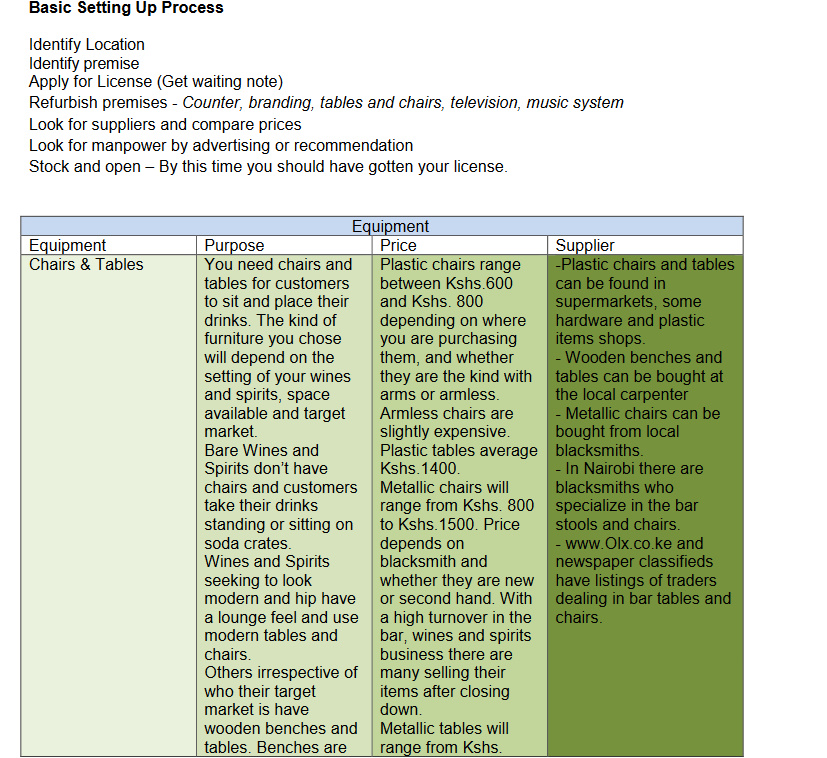Wines and Spirits Retail Business Plan
Wines and Spirits Retail Business Plan

Wines and Spirits Retail Business Plan Overview
This Wines and Spirits Retail Business Plan is about business of selling Wines and Spirits in retail.
Licenses:
Licensing of bars, wines and spirits business is governed by the Alcoholics Drink Act, 2010. However since 2013 many county governments have come up with their own custom legislation which if strictly implemented could affect the Wines & Spirits in one way or another.
The Alcoholic Drinks Act, 2010 is commonly known as the Mututho law defines the licensing requirements and fees. And although the counties have passed their own liquor laws licensing is basically governed by the Mututho laws.
Three licenses are of interest. General Retail Alcoholic License, Wholesale License, General Retail License Off License.
Location
When selecting the location and premises consider:
- The demographics in the area
- Is it a place consumers are likely to favorably respond positively to a Wines and Spirits?
- What are the income levels?
- Competition
- Authorities
- Renovation
For instance if you are targeting a low end market no need to stock Smirnoff. Also if you are operating quite a distant from a wholesaler then you need to stock more to avoid making many trips to restock. And although it’s a Wines and Spirits you will need to have the most common of beer brands- Tusker, Submit, Pilsner, Allsops, Smirnoff Ice and some Redds.
The Market
The market for Wines and Spirits has been changed rapidly since the beginning of 2022. Since the second half of 2022 the inflation rates have on average been above 6% hitting highs of 8% in 2023. The high inflation rates have reduced the disposable income putting strain on consumers especially the lower income and lower middle income groups. This has in turn increased the demand for spirits. Spirits are more affordable in the sense that for a lesser amount one gets the same effect as 3 or 4 times the amount that he could have spent on bottled beer.
The increase in prices led many Keg consumers to shift to spirits to an extent that in July 2014 East Africa Breweries limited ( EABL ) said it was contemplating stopping production of Keg all together. In October 2014 the company laid off 100 employees in the Keg production unit. They now brew Keg only twice per week from a high of 5 days. However after spirit related deaths in 2014 Senator Keg is making resurgence though not to pre 2013 levels. A number of Wines and Spirits have also started selling Keg.
The market for fake spirits has expanded and moving to almost mainstream distribution channels. Fakes have become more attractive to retailers because of the margins they offer which at times are double what the genuine spirits give.
With increased competition in the business Wines and Spirits want to be able to compete on price and margins, and fakes help them do that. In lower income areas it then becomes tough for wines and spirits selling genuine products to compete with those selling fakes. In middle income areas there is the same challenge but because there are many more factors affecting patronage other than price a business is able to survive even when competing with those selling fakes.
In all regions there have been a high number of wines and spirits opening and closing. The reasons for this range from increased competition, regulatory reasons and perceptions.
There has been an increase in hip wines and spirits, unlike the standard wines and spirits which have been common for many years. The hip wines and spirits seek to offer a more ‘modern’ wines and spirits experience away from the ‘cheap’ image that had existed before.
In Nairobi there are now many Wines and Spirits operating throughout the day. This has nothing to do with licenses since some have none of the relevant rather illegal collaborations with the local authorities.
Download Wines and Spirits Retail Business Plan / guide here